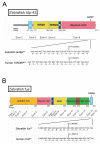Homology Directed Knockin of Point Mutations in the Zebrafish tardbp and fus Genes in ALS Using the CRISPR/Cas9 System
- PMID: 26930076
- PMCID: PMC4773037
- DOI: 10.1371/journal.pone.0150188
Homology Directed Knockin of Point Mutations in the Zebrafish tardbp and fus Genes in ALS Using the CRISPR/Cas9 System
Abstract
The methodology for site-directed editing of single nucleotides in the vertebrate genome is of considerable interest for research in biology and medicine. The clustered regularly interspaced short palindromic repeats (CRISPR)/CRISPR-associated protein 9 type II (Cas9) system has emerged as a simple and inexpensive tool for editing genomic loci of interest in a variety of animal models. In zebrafish, error-prone non-homologous end joining (NHEJ) has been used as a simple method to disrupt gene function. We sought to develop a method to easily create site-specific SNPs in the zebrafish genome. Here, we report simple methodologies for using CRISPR/Cas9-mediated homology directed repair using single-stranded oligodeoxynucleotide donor templates (ssODN) for site-directed single nucleotide editing, for the first time in two disease-related genes, tardbp and fus.
Conflict of interest statement
Figures




Similar articles
-
CRISPR/Cas9-mediated homology-directed repair by ssODNs in zebrafish induces complex mutational patterns resulting from genomic integration of repair-template fragments.Dis Model Mech. 2018 Oct 18;11(10):dmm035352. doi: 10.1242/dmm.035352. Dis Model Mech. 2018. PMID: 30355591 Free PMC article.
-
CRISPR/Cas9 and TALEN-mediated knock-in approaches in zebrafish.Methods. 2014 Sep;69(2):142-50. doi: 10.1016/j.ymeth.2014.03.027. Epub 2014 Apr 1. Methods. 2014. PMID: 24704174
-
Exogenous gene integration mediated by genome editing technologies in zebrafish.Bioengineered. 2017 May 4;8(3):287-295. doi: 10.1080/21655979.2017.1300727. Epub 2017 Mar 8. Bioengineered. 2017. PMID: 28272984 Free PMC article. Review.
-
Programmable base editing of zebrafish genome using a modified CRISPR-Cas9 system.Nat Commun. 2017 Jul 25;8(1):118. doi: 10.1038/s41467-017-00175-6. Nat Commun. 2017. PMID: 28740134 Free PMC article.
-
CRISPR/Cas9-Mediated Gene Correction to Understand ALS.Int J Mol Sci. 2020 May 27;21(11):3801. doi: 10.3390/ijms21113801. Int J Mol Sci. 2020. PMID: 32471232 Free PMC article. Review.
Cited by
-
Homology-Directed Repair in Zebrafish: Witchcraft and Wizardry?Front Mol Biosci. 2020 Dec 7;7:595474. doi: 10.3389/fmolb.2020.595474. eCollection 2020. Front Mol Biosci. 2020. PMID: 33425990 Free PMC article. Review.
-
A robust pipeline for efficient knock-in of point mutations and epitope tags in zebrafish using fluorescent PCR based screening.BMC Genomics. 2022 Dec 7;23(1):810. doi: 10.1186/s12864-022-08971-1. BMC Genomics. 2022. PMID: 36476416 Free PMC article.
-
A Functional Binding Domain in the Rbpr2 Receptor Is Required for Vitamin A Transport, Ocular Retinoid Homeostasis, and Photoreceptor Cell Survival in Zebrafish.Cells. 2020 Apr 29;9(5):1099. doi: 10.3390/cells9051099. Cells. 2020. PMID: 32365517 Free PMC article.
-
Small fish, big prospects: using zebrafish to unravel the mechanisms of hereditary hearing loss.Hear Res. 2020 Nov;397:107906. doi: 10.1016/j.heares.2020.107906. Epub 2020 Feb 6. Hear Res. 2020. PMID: 32063424 Free PMC article.
-
Updated summary of genome editing technology in human cultured cells linked to human genetics studies.J Hum Genet. 2018 Feb;63(2):133-143. doi: 10.1038/s10038-017-0349-z. Epub 2017 Oct 11. J Hum Genet. 2018. PMID: 29167553 Review.
References
Publication types
MeSH terms
Substances
Grants and funding
LinkOut - more resources
Full Text Sources
Other Literature Sources
Medical
Molecular Biology Databases
Research Materials
Miscellaneous

